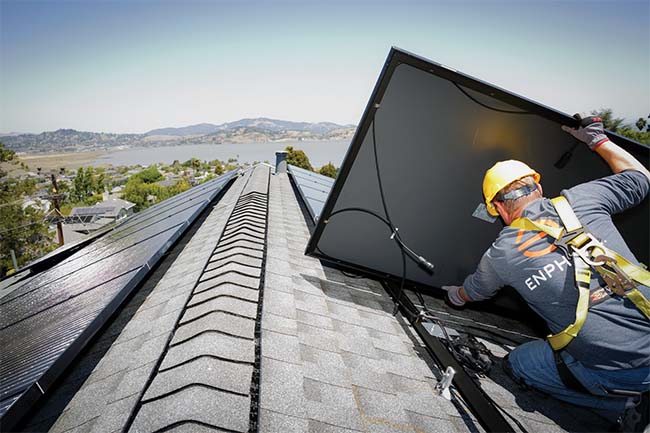Technology Advancements Support Distributed Solar Generation
Upgraded equipment, new software, and innovations to serve both residential, and commercial and industrial customers are changing the solar power industry.
Decentralized power generation continues to grow, providing companies in the solar power sector more opportunities to develop technologies to support both economic and efficiency gains, be it with better equipment, software, or installation strategies. New technologies for residential (Figure 1), and commercial and industrial solar power applications are being introduced regularly, which means customers have more choices when it comes to determining what works best as they design a distributed generation system.
 |
|
1. Advancements in solar panel technology, and a continued need to control energy costs, are spurring installations of rooftop solar. Courtesy: Enphase Energy |
“Businesses and labs are examining various technologies for enhancing future distributed solar power generation at the residential level. One notable area of research is advanced energy storage solutions,” said Kelly Warner, CEO of Lumin, a company involved in responsive load control. “Solid-state batteries and next-generation lithium-ion technologies are at the forefront of these developments, offering the potential for increased energy density, extended lifespans, and enhanced safety. These improvements are essential for optimizing the benefits of residential solar systems, allowing homeowners and utilities to store excess energy and use it when needed.”
Ryan Pierce, solar business development manager at Houston, Texas–based NOV Renewables, told POWER, “At NOV, we are seeing a surge in interest for distributed solar power generation, more specifically in the commercial and industrial sectors. Over the past few months, we have received multiple bid requests that include the integration of advanced solar panels available in the market from brands like Canadian Solar, which has been at the forefront of solar technology innovation.”
For more insight into distributed solar power generation, read this POWER Interview with David Dunlap of BayWa r.e.
Pierce said those innovations in panels “have shown exceptional performance with bifacial gains upwards of 20%, allowing them to capture sunlight from both the front and rear sides of the panel. These panels boast nominal max power ratings of over 800 watts, and module efficiencies that surpass 26%. Although the initial costs of these larger panels are higher compared to their lower-wattage counterparts, and they result in fewer panels being installed per row, the increased module efficiency and total overall wattage output contributes to a reduction in the levelized cost of energy.
“Additionally, the proportion of total commercial electricity sales to commercial, non-profit, and public entities met by onsite solar is experiencing a significant upswing,” said Pierce. “This growth is predominantly driven by major retailers, technology companies operating data centers, educational institutions, and government and municipal buildings, who are all seeking to meet their electricity demands through solar power.”
Advanced Technologies
Warner said utilities can benefit from integrating distributed solar and energy storage, managed by smart panel technology. “This approach allows them to participate in demand response programs, ensuring more efficient grid operations, cost-effectiveness, and enhanced grid reliability,” said Warner. “Ultimately, the amalgamation of distributed solar power generation and smart electrical panels presents a remarkable opportunity for utilities to play a central role in a more equitable, clean energy future. It enables them to meet the challenges of rising energy demand while contributing to grid stability and cost-efficiency through effective demand response strategies.”
Those strategies include the use of new technologies designed for better efficiency, and that can offer cost savings. Pierce said, “The trend in the distributed generation space is evolving, with a noticeable shift from fixed-tilt systems to trackers, driven by several technical factors. The overall cost of single-axis tracker projects has fluctuated in recent years … depending on site layout, tracker projects [may] prove more economical than their fixed-tilt counterparts.”
“Microgrids and the integration of several technologies like solar, energy storage, load control, and EV [electric vehicle] charging are the hot topics in the distributed renewable energy industry,” said Will White, solar application specialist with Fluke Solar. “As technology evolves, they’ll work together seamlessly to provide a comprehensive energy solution.”
Enphase already introduced the company’s IQ8 series microinverters, the industry’s first grid-forming microinverters with split-phase power conversion capability, enabling efficient conversion from DC power to AC power. Andy Newbold, Enphase’s head of Corporate Affairs, told POWER, “The brain of the semiconductor-based microinverter is our proprietary application-specific integrated circuit [ASIC], which enables the microinverter to operate in grid-tied or off-grid modes. This chip is built in advanced 55-nm [nanometer] technology with high-speed digital logic and has super-fast response times to changing loads and grid events, alleviating constraints on battery sizing for home energy systems.”
Newbold also noted Enphase “is now working on the IQ9 family of microinverters, which is expected to be introduced to the market in 2024.” Newbold said the IQ9 microinverters will support even higher DC input currents and higher AC grid voltages.
SolarEdge in September introduced the company’s bidirectional DC EV charger, which enables solar-powered vehicle-to-home (V2H) and vehicle-to-grid (V2G) functionalities. The company, as part of its appearance at September’s RE+ trade show in Las Vegas, Nevada (POWER is a media partner for the event), also showcased its Home Hub and Wave Inverters. These next-generation inverters include embedded power control systems that allow more than 50% larger systems to be installed without main panel upgrades.
The company also introduced commercial innovations such as the SE-330K Inverter and H1300 Power Optimizer for community solar and agriculture-related PV applications. It also unveiled the SolarEdge ONE Manager, an energy management system for commercial and industrial applications. It’s a cloud-enabled platform that provides real-time data analytics on energy production, consumption, EV charging, and load management, while reducing operational costs.
Anker SOLIX this year introduced what the company called a “hybrid category” to its residential line of solar energy products, highlighting both its X1 Home Energy Solution and the F3800 Portable Power Station at the RE+ event. The X1 is designed to provide long-lasting backup power to the home. The system’s flexible modular design is customizable with up to six battery packs per system (30 kWh), or up to six systems in parallel (180 kWh), storing solar power for use as needed such as in the event of an outage.
During blackouts, the X1 will work with the homeowner’s PV panels to power the home, seamlessly switching to off-grid mode in less than 15 milliseconds. The company said that through the Anker app, users can manage all aspects of the X1 system and control energy usage for other devices, including heat pumps, generators, EV chargers, and more.
Anker SOLIX said the F3800 Portable Power Station is the first of its type to feature AC coupling; it can support home solar power cycling when paired with the Anker SOLIX Home Power Panel. It offers 6,000 watts of AC power output and 120V/240V dual voltage output, enabling it to simultaneously power high-energy devices. The system includes a 3.84-kWh internal battery for extended backup power.
Solar Building Facades
ENVELON, based in Germany, is involved with building integrated photovoltaic, or BIPV, technology that “utilizes the unused building envelopes for onsite solar power generation,” according to the company. Gary Shaver, the company’s president and managing director for North America, told POWER the company leverages the latest solar and building industry technologies to suit several building types (Figure 2), working with both new construction and retrofits. The company’s approach to distributed solar provides greater access to solar in urban areas, with Shaver noting that includes areas where it may not be feasible to install rooftop solar due to heating, ventilation, and ari conditioning systems, or building amenities, including rooftop gardens or playgrounds.
 |
|
2. ENVELON considers this building one of its “showcase” projects. This building, known as Max, is part of the Max & Moore business complex in Amsterdam. The building’s facade, with integrated photovoltaic modules, provides solar power for the building. Courtesy: ENVELON |
“ENVELON transforms conventional buildings into beautiful, state-of-the art solar power plants using its solar facade system,” said Shaver. “A combination of cutting-edge solar and color technologies generates climate-friendly electricity from solar energy in a safe and reliable manner.”
Shaver told POWER, “The ENVELON system takes advantage of a variety of industry-trusted mounting substructures that are hidden behind ENVELON’s architectural facade panels, which allow for effective installation and maintenance. Both the mechanical connections to the building and the associated electrical wiring conform to building and electrical safety codes.” The company currently is focused on cutting-edge nano-ceramic color coating technology that is infused directly into the glass, which means it is not exposed to weathering, and enabling improved laminate adhesion.
Shaver said the company can provide different colors and patterns “for its frameless glass facades that combine beauty and functionality. Each color is realized using an ultra-thin internal coating that selects a specific component of the color spectrum—achieving greater than 90% light transmittance for some colors while generating solar-powered energy.”
Solar, Storage, and EV Charging
Olaf Lohr, business development manager at AutoGrid, a software group, told POWER: “Lately, we are seeing more hybrid inverters that integrate solar PV and batteries, as well as integrated battery storage systems that can accept direct input from solar PV.” Lohr said that while solar and EV charging are not directly linked, aggregators including AutoGrid “are solving part of this issue by providing price or GHG [greenhouse gas] signals to direct EV charging toward periods of abundant solar production. This resolves the issue by integrating intermittent PV production with EV charging in a way that is driven by consumer behavior.”
Said Lohr: “The best battery storage systems to pair with customer-sited solar are those that can help customers maximize the full value stack. These systems should provide backup power, manage demand charges, accommodate time-of-use pricing, and enhance self-consumption. This is important when the value of solar is decreasing due to new net energy metering regulations. Additionally, ideal battery storage systems to pair with distributed solar should optimize energy flows behind the meter.”
Lohr continued: “In terms of new technologies, we are seeing a closer integration of PV and EV charging, including V2G, into consumer opportunities. These are supported by intelligent systems that optimize for energy bills and GHG emissions, and they can also connect to support an evolving grid.”
—Darrell Proctor is a senior associate editor for POWER (@POWERmagazine).